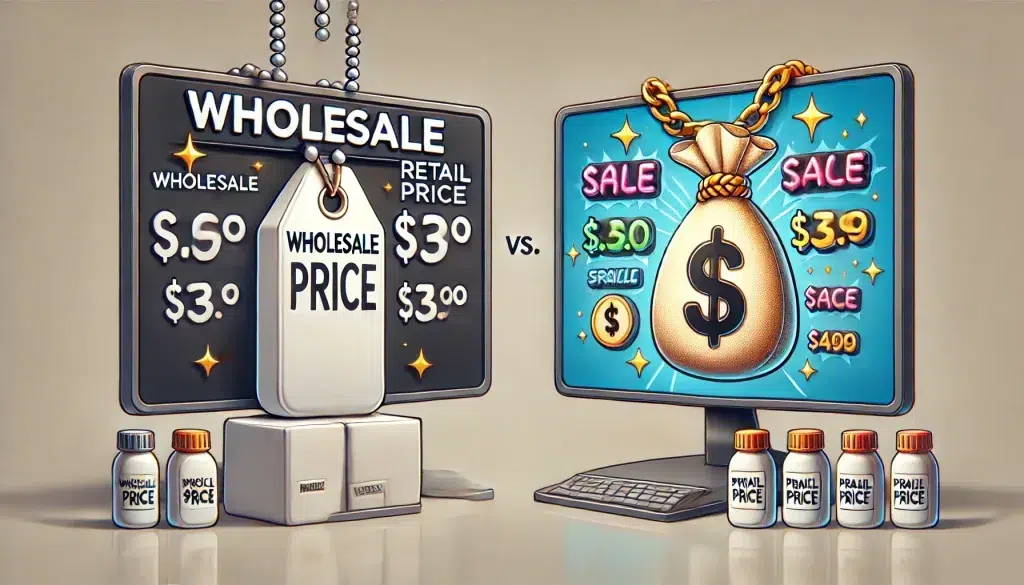
Understanding the difference between wholesale and retail prices is crucial for both businesses and consumers. This article breaks down these pricing concepts and their impact on the market.
What is Wholesale Price?
Wholesale price is the amount a manufacturer or distributor charges retailers for products in bulk quantities.
Key characteristics of wholesale prices:
- Lower than retail prices
- Often involves minimum order quantities
- Typically only available to businesses with resale licenses
What is Retail Price?
Retail price is the final cost consumers pay for individual products in stores or online.
Key characteristics of retail prices:
- Higher than wholesale prices
- Includes markup to cover business costs and profit
- Available to general consumers
Wholesale vs. Retail Price: Main Differences
Intended Buyer:
- Wholesale: Businesses (retailers, resellers)
- Retail: End consumers
Quantity:
- Wholesale: Bulk purchases
- Retail: Individual or small quantity purchases
Pricing:
- Wholesale: Lower per-unit cost
- Retail: Higher per-unit cost
Profit Margin:
- Wholesale: Smaller profit margin per unit
- Retail: Larger profit margin per unit
Accessibility:
- Wholesale: Limited to businesses with proper credentials
- Retail: Open to general public
How to Calculate Retail Price from Wholesale
To determine retail price:
- Start with the wholesale price
- Add desired markup percentage
- Consider market factors and competition
Formula: Retail Price = Wholesale Price + (Wholesale Price × Markup Percentage)Example:
- Wholesale Price: $50
- Desired Markup: 100%
- Retail Price: $50 + ($50 × 100%) = $100
Impact on Business and Consumers
Understanding wholesale vs. retail pricing affects:
- Business profitability
- Consumer purchasing decisions
- Market competition
- Supply chain dynamics
How Pricefy can help
Pricefy offers a powerful solution for businesses looking to optimize their wholesale pricing strategies.
With its advanced algorithms and real-time market data analysis, Pricefy helps companies set competitive wholesale prices that maximize profitability while maintaining market share.
The platform’s dynamic pricing engine automatically adjusts wholesale rates based on factors such as inventory levels, competitor pricing, and demand fluctuations.
Pricefy also provides detailed insights and reporting tools, allowing businesses to track performance, identify trends, and make data-driven decisions.
By streamlining the wholesale pricing process, Pricefy enables companies to respond quickly to market changes, negotiate better deals with suppliers, and maintain healthy profit margins.
Whether you’re a manufacturer, distributor, or retailer, Pricefy’s comprehensive suite of tools can help you navigate the complexities of wholesale pricing and gain a competitive edge in your industry.
FAQs
- Q: Can individuals buy at wholesale prices?
A: Generally, wholesale prices are reserved for businesses, but some suppliers may offer bulk purchases to individuals. - Q: What’s a typical markup from wholesale to retail?
A: Markup varies by industry but often ranges from 50% to 100% or more. - Q: How do retailers determine their markup?
A: Retailers consider factors like operating costs, competition, and target profit margins. - Q: Are wholesale prices always fixed?
A: No, wholesale prices can be negotiable, especially for large orders or long-term contracts. - Q: What’s the difference between markup and margin?
A: Markup is calculated on the cost price, while margin is calculated on the selling price.
Useful Links
By grasping these pricing concepts, businesses can optimize their strategies, and consumers can make more informed purchasing decisions.




